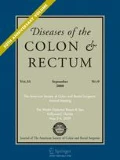Abstract
PURPOSE: Topical glyceryl trinitrate heals anal fissures, but a majority of patients experience headache. Topical gels of the calcium channel blocker diltiazem and the cholinomimetic bethanechol significantly lower and sphincter pressure in volunteers. This study investigated the use of these two new pharmacologic agents in the treatment of patients with chronic anal fissure. METHODS: Two studies were conducted, each involving 15 patients with chronic anal fissure. In each study patients underwent anal manometry and laser doppler flowmetry before treatment. They were treated with either 2 percent diltiazem gel or 0.1 percent bethanechol gel three times daily for eight weeks. Assessment every two weeks was by clinical examination, repeat anal manometry, and laser doppler flowmetry. Daily pain was assessed by linear analog charts. RESULTS: Fissures healed in 10 of 15 (67 percent) patients treated with 2 percent diltiazem gel and in 9 (60 percent) patients treated with 0.1 percent bethanechol gel. There was no significant difference in the pretreatment maximum resting sphincter pressure (MRP) between responders and nonresponders in either group. There was significant reduction in the pain score after treatment with diltiazem (P=0.002) and bethanechol (P=0.005) compared with that before treatment. MRP was significantly lower after diltiazem (P=0.0001) and bethanechol (P=0.02) compared with pretreatment MRP. No headaches or side effects were reported. CONCLUSIONS: Both topical diltiazem and bethanechol substantially reduce anal sphincter pressure and achieve fissure healing to a similar degree reported with topical nitrates, but without side effects.
Similar content being viewed by others
References
Hananel N, Gordon PH. Lateral internal sphincterotomy for fissure-in-ano revisited. Dis Colon Rectum 1997;40:597–602.
Rosen L, Abel ME, Gordon PH,et al. Practice parameters for the management of anal fissure. Dis Colon Rectum 1992;35:206–8.
O'Kelly TJ, Brading AF, Mortensen NJ. Nerve mediated relaxation of the human internal and sphincter: the role of nitric oxide. Gut 1993;34:689–93.
Rattan S, Chakder S. Role of nitric oxide as a mediator of internal anal sphincter relaxation. Am J Physiol 1992;262:G107–12.
Khubchandani IT, Reed JF. Sequelae of internal sphincterotomy for chronic fissure in ano. Br J Surg 1989;76:431–4.
Walker WA, Rothenberger DA, Goldberg SM. Morbidity of internal sphincterotomy for anal fissure and stenosis. Dis Colon Rectum 1985;28:832–5.
Loder PB, Kamm MA, Nicholls RJ, Phillips RK. “Reversible chemical sphincterotomy” by local application of glyceryl trinitrate. Br J Surg 1994;81:1386–9.
Lund JN, Scholefield JH. A randomised, prospective, double-blind, placebo-controlled trial of glyceryl trinitrate ointment in treatment of anal fissure. Lancet 1997;349:11–4.
Carapeti EA, Kamm MA, McDonald PJ, Chadwick SJ, Melville D, Phillips RK. Randomised controlled trial shows that glyceryl trinitrate heals anal fissures, higher doses are not more effective, and there is a high recurrence rate. Gut 1999;44:727–30.
Staneva-Stoytcheva D, Venkova K. Effects of the calcium antagonists diltiazem, verapamil and nitrendipine on the contractile responses of guinea-pig isolated ileum to electrical stimulation or carbachol. J Pharm Pharmacol 1992;44:321–5.
Morales-Olivas FJ, Cortijo J, Esplugues JV, Rubio E, Esplugues J. Effect of verapamil and diltiazem on isolated gastro-oesophageal sphincter of the rat. J Pharm Pharmacol 1985;37:208–9.
Chrysos E, Xynos E, Tzovaras G, Zoras OJ, Tsiaoussis J, Vassilakis SJ. Effect of nifedipine on rectoanal motility. Dis Colon Rectum 1996;39:212–6.
Jonard P, Essamri B. Diltiazem and internal anal sphincter [letter]. Lancet 1987;1:754.
Frenckner B, Ihre T. Influence of autonomic nerves on the internal and sphincter in man. Gut 1976;17:306–12.
Burleigh DE, D'Mello A, Parks AG. Responses of isolated human internal anal sphincter to drugs and electrical field stimulation. Gastroenterology 1979;77:484–90.
O'Kelly TJ, Brading A, Mortensen NJ. In vitro response of the human anal canal longitudinal muscle layer to cholinergic and adrenergic stimulation: evidence of sphincter specialization. Br J Surg 1993;80:1337–41.
Carapeti EA, Kamm MA, Phillips RK. Diltiazem lowers resting anal sphincter pressure—a potential low side-effect alternative to glyceryl trinitrate for fissures [abstract]. Gut 1998;42:A97.
Carapeti EA, Kamm MA, Evans BK, Phillips RK. Topical diltiazem and bethanechol decrease anal sphincter pressure without side-effects. Gut 1999;45:719–22.
Arabi Y, Alexander-Williams J, Keighley MR. Anal pressures in hemorrhoids and anal fissure. Am J Surg 1977;134:608–10.
Schouten WR, Briel JW, Boerma MO, Auwerda JJ, Wilms EB, Graatsma BH. Pathophysiological aspects and clinical outcome of intra-anal application of isosorbide dinitrate in patients with chronic anal fissure. Gut 1996;39:465–9.
Mangione NJ, Glasser SP. Phenomenon of nitrate tolerance. Am Heart J 1994;128:137–46.
Watson SJ, Kamm MA, Nicholls RJ, Phillips RK. Topical glyceryl trinitrate in the treatment of chronic anal fissure. Br J Surg 1996;83:771–5.
Maria G, Cassetta E, Gui D, Brisinda G, Bentivoglio AR, Albanese A. A comparison of botulinum toxin and saline for the treatment of chronic anal fissure. N Engl J Med 1998;338:217–20.
Author information
Authors and Affiliations
Additional information
Topical preparations supplied by Slaco Pharmaceuticals, Limited, United Kingdom.
E. Carapeti is supported by the Robert Luff Foundation.
Presented in part at the meetings of the American Gastroenterology Association, New Orleans, Louisiana, May 16 to 22, 1998; the British Society of Gastroenterology, Harrogate, United Kingdom, March, 10 to 13, 1998; and the Association of Surgeons of Great Britain and Ireland, Edinburgh, United Kingdom, May 13 to 15, 1998.
About this article
Cite this article
Carapeti, E.A., Kamm, M.A. & Phillips, R.K.S. Topical diltiazem and bethanechol decrease anal sphincter pressure and heal anal fissures without side effects. Dis Colon Rectum 43, 1359–1362 (2000). https://doi.org/10.1007/BF02236630
Issue Date:
DOI: https://doi.org/10.1007/BF02236630




